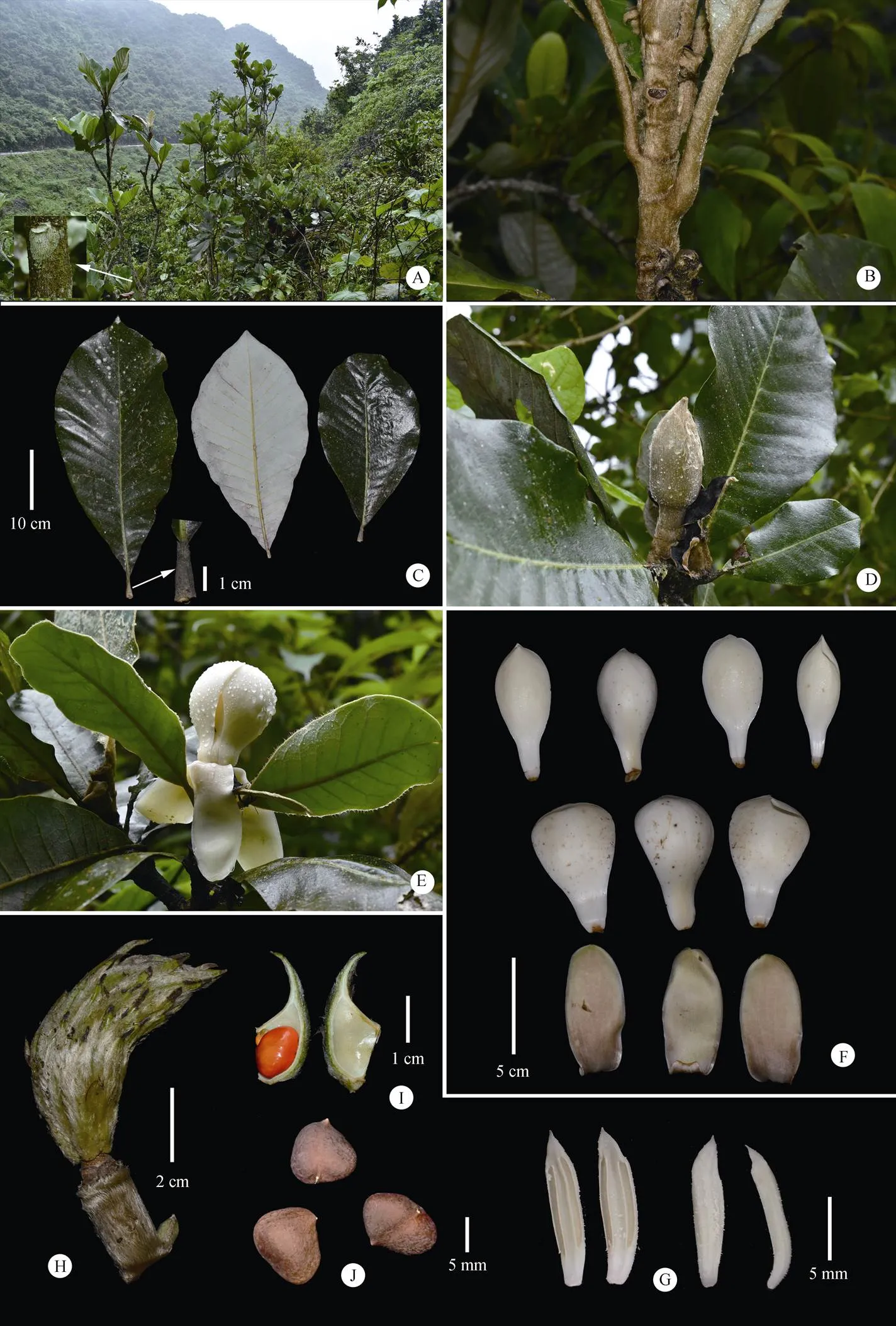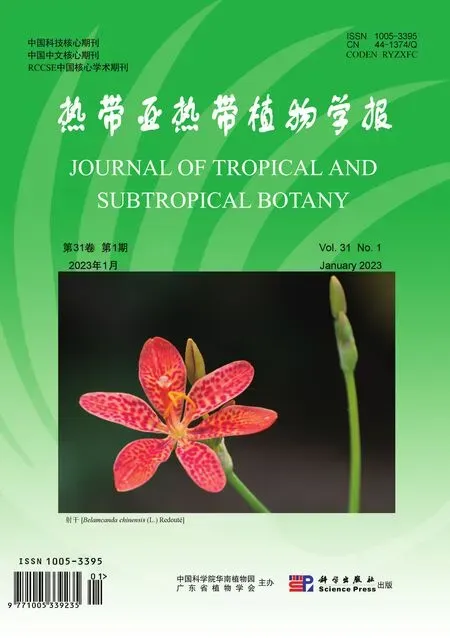靖西长喙木兰,广西木兰科一新种
童毅华, 李兴康, 夏念和*
靖西长喙木兰,广西木兰科一新种
童毅华1,2, 李兴康3, 夏念和1,2*
(1. 中国科学院华南植物园,中国科学院植物资源保护与可持续利用重点实验室,广东省数字植物园重点实验室,广州 510650;2. 华南国家植物园,广州 510650;3. 广西邦亮长臂猿国家级自然保护区,广西 靖西 533899)
描述了产自广西木兰科一新种:靖西长喙木兰(Y. H. Tong & N. H. Xia)。本种形态上与绢毛木兰[(Chun & C. H. Tsoong) N. H. Xia & C. Y. Wu]接近,但区别在于该种植株较矮,幼枝、叶柄和幼叶被黄棕色绢毛, 叶柄较宽,叶片较宽,倒卵形或倒卵状椭圆形,先端钝或短渐尖,花被片较大,心皮数目较多,被黄棕色绢毛。
IUCN;sect.; 分类学
The genusL. (Magnoliaceae) includes ca. 26 species mainly distributed from East Himalaya through South China to Southeast Asia[1–8]. China owns 10 species of this genus[1,9].is charac- terized by evergreen habit, petiole with a stipular scar, spirally arranged leaves folded in bud, terminal flowers, gynoecium without a gynophore, 2(–4) ovules per carpel, ellipsoid fruit and mature carpels with a beaked apex and dehiscing longitudinally or peripherally[1,9]. Many recent molecular phylogenetic studies supported that(orsect.DC. including subsect.(Blume) Figlar & Noot.) is monophyletic[10–14], and as pointed out by Wang et al.[15], concepts of small genera are more practical, especially for those countries that harbor a high diversity of magnolias, such as China where nearly one third of the species of the whole world are distributed. Thus, instead of a section of, the generic rank ofis adopted here.
During a recent field trip to a limestone area near the border of China and Vietnam in Jingxi City, Guangxi Zhuang Autonomous Region, China, an unknown shrub or small tree ofwas found. The sericeous young branches and leaves of this unknown species seem like those of(Chun & C. H. Tsoong) N. H. Xia & C. Y. Wu, but the latter species is a big tree with much narrower leaf blades. After a detailed examination of the morpho- logical characters of this unknown species and referring to related literatures[2–4,6–8,16–18]and herbarium speci- mens, we concluded that this species is new to science, which is described and illustrated below.
Y. H. Tong & N. H. Xia, sp. nov. (Fig. 1)
Type: China, Guangxi Zhuang Autonomous Region, Baise City, Jingxi City, Longbang Town, near Bandan Village, 10 June 2020 (fl.), Nian-He Xia, Hai- Shan Chen, Shi-Jin Li, Yi-Hua Tong, Xing-Kang Li TYH-2505 (holotype: IBSC, isotypes IBSC, IBK).
Diagnosis: This species is similar to, but differs from the latter in having a much shorter height (1–4 m vs. up to 8 m), yellowish-brown sericeous (vs. white sericeous) young branches, petioles and leaf blades, wider petiole (4–6 mm vs. 2– 3 mm), obovate or obovate-elliptic (vs. elliptic, narrowly elliptic, or narrowly obovate-elliptic) and wider (11–21 cm vs. 6–9(–15) cm) leaf blades with an obtuse or shortly acuminate (vs. acuminate) apex, larger tepals, and gynoecium with more (35 to 46 vs. ca. 24) and yellowish-brown sericeous (vs. brownish or white pubescent) carpels. A more detailed compa- rison of the two species is provided in Table 1.

Table 1 Morphological comparison between Lirianthe jingxiensis and L. albosericea
Description: Shrubs or small trees, 1–4 m tall, evergreen. Bark gray or grayish white, rough. Young parts, such as branches, petioles and leaf blades, densely yellowish-brown sericeous. Stipular scar nearly reaching apex of petiole. Petiole thick and robust, 1–2 cm long, 4–6 mm wide; leaf blade obovate or obovate-elliptic, 18–43 cm×11–21 cm, adaxially dark green, abaxially pale green, initially yellowish- brown sericeous both sides, glabrescent, secondary veins 15 to 22 on each side of midvein, base cuneate to broadly cuneate, apex obtuse or shortly acuminate. Peduncle 3.0–4.5 cm long, densely yellowish-brown sericeous, with 2 to 3 bract scars. Flower buds ovoid- ellipsoid, 4–5 cm long. Tepals 9, white; tepals of outer whorl oblong, 5.5–7.0 cm×2.3–3.2 cm, sub-leathery, densely papillate, yellowish-brown sericeous near base; tepals of middle whorl obovate to obovate- spatulate, 6.2–7.5 cm×3.5–4.0 cm, thickly fleshy, glabrous; tepals of inner whorl similar to those of middle whorl but shorter and slightly narrower, 5.0– 6.5 cm×2.0–3.5 cm. Stamens ca. 140, 1.0–1.3 cm long, ca. 2.5 mm wide; connective exserted and forming a triangular mucro; anthers 5.5–7.5 mm long, dehiscing introrsely. Carpels 35 to 46, narrowly ellipsoid, 1.3– 1.5 cm, abaxially yellowish sericeous and inconspi- cuously papillate, shallow furrow reaching to apex in middle; ovules 2 per carpel. Fruit dark brown, ellipsoid, 7–8 cm long; mature carpels narrowly ellipsoid, 2.3–3.2 cm long, leathery, abaxially more or less yellowish-brown sericeous, apex with a slightly curved beak. Seeds (testa) red, irregularly triangular, 10–12 mm×8–10 mm×5–6 mm, laterally flat, adaxially shallowly and narrowly furrowed, base cuneate, apex finely pitted.

Fig. 1 Lirianthe jingxiensis. A: Habit and habitat, the arrow shows bark; B: Young branches and petioles with yellowish-brown sericeous indumentum; C: Leaves, the arrow shows stipular scar; D: Flowering branch with flower bud; E: Flowering branch with flower; F: Tepals of outer (bottom), middle and inner (top) whorl; G: Stamens; H: Fruit; I: Opened mature carpel with one developed seed and the other undeveloped seed; J: Seeds with testa removed. (Photoed by Yi-Hua Tong)
Etymology: The species epithet refers to the type locality, Jingxi City in Guangxi, China.
Distribution and habitat: This new species is now known only from the type locality. Since the type locality is near to the border of China and Vietnam, it is possibly distributed in Vietnam too. It grows in the thickets on limestones at elevations of 700–820 m.
Conservation status: Only one population with ca. 80 mature individuals of this species was disco- vered in the type locality by us, and the habitat is near to a road with large traffic flow and thus fragile and disturbed strongly by human activity. Thus, according to the IUCN red list categories and criteria, the conservation status of this species is provisionally assessed as ‘Endangered’ (EN, Criterion D)[19].
Phenology: This new species flowers in June, and fruits in September.
Additional specimens examined (paratypes): China, Guangxi Zhuang Autonomous Region: the same locality as type specimens, 21 June 2010 (fl), Li-Ying Yu YLYJX0071(GXMG); ibid., 6 September 2011 (fr.), Yu-Song Huang Y0724 (IBK); ibid., 6 June 2020 (fl.), Bing-Mou Wang TYH-2499 (IBSC).
Discussion: This new species is morphologically most similar to, and the two species differ from otherspecies by having stipular scar reaching apex of petiole, petiole usually shorter than 3 cm long, medium-sized (shorter than 45 cm) leaf blade, young parts with sericeous trichomes and outer tepals longer than 4 cm[1].is of high ornamental value due to its relatively small size and large flowers compared with other magnolias.
We are grateful to Dr. Shi-Jin Li, Dr. Hai-Shan Chen and Mr. Yu-Song Huang for their help during field trips. Our thanks also go to the curators of GXMG, IBK and IBSC for allowing us to examine the specimens.
[1] XIA N H, LIU Y H, NOOTEBOOM H P. Magnoliaceae [M]// WU Z Y, RAVEN P H. Flora of China, Vol. 7. Beijing: Science Press & St. Louis: Missouri Botanical Garden Press, 2008: 48–91.
[2] VU Q N. Taxonomic revision of the family Magnoliacea from Vietnam [D]. Beijing: Graduate University of the Chinese Academy of Sciences, 2011: 1–241.
[3] VU Q N.sp. nov. (Magnoliaceae) from Vietnam [J]. Nord J Bot, 2014, 32: 815–818. doi: 10.1111/njb.00536.
[4] VU Q N, XIA N H.(Magnoliaceae), a new species from Vietnam [J]. Ann Bot Fennici, 2011, 48: 525–527.
[5] SIMA Y K, LU S G. A new system for the family Magnoliaceae [C]// XIA N H, ZENG Q W, XU F X, et al. Proceeding of the Second International Symposium on the Family Magnoliaceae. Wuhan: Huazhong University Science Technology Press, 2012: 55–71.
[6] NONG V D, PHAN N H T, TRAN V T, et al.sp. nov. from Vietnam [J]. Nord J Bot, 2015, 33: 438–441. doi: 10.1111/njb. 00540.
[7] VU T C, NONG V D, PHAN N H T, et al. Additions to the Vietnamese species ofL. sect.DC. (Magnoliaceae) [J]. Adansonia, sér. 3, 2015, 37: 13–18. doi: 10.5252/a2015n1a2.
[8] VU Q N, XIA N H, NGUYEN T T, et al.(Magnoliaceae), a new species from northern Vietnam [J]. Phytotaxa, 2020, 464: 188–192. doi: 10.11646/phytotaxa.464.2.7.
[9] SHUI Y M, SIMA Y K, WEN J, et al. Vouchered Flora of Southeast Yunnan, Vol. 1 [M]. Kunming: Yunnan Publishing Group Corporation, Yunnan Science & Technology Press, 2010: 1–152.
[10] NIE Z L, WEN J, AZUMA H, et al. Phylogenetic and biogeographic complexity of Magnoliaceae in the Northern Hemisphere inferred from three nuclear data sets [J]. Mol Phyl Evol, 2008, 48: 1027–1040. doi: 10.1016/j.ympev.2008.06.004.
[11] AZUMA H, CHALERMGLIN P, NOOTEBOOM H P. Molecular phylogeny of Magnoliaceae based on plastid DNA sequences with special emphasis on some species from continental Southeast Asia [J]. Thai For Bull, 2011, 39: 148–156.
[12] KIM S, SUH Y. Phylogeny of Magnoliaceae based on ten chloroplast DNA regions [J]. J Plant Biol, 2013, 56: 290–305. doi: 10.1007/s123 74-013-0111-9.
[13] WANG Y B, LIU B B, NIE Z L, et al. Major clades and a revised classification ofand Magnoliaceae based on whole plastid genome sequencesgenome skimming [J]. J Syst Evol, 2020, 58: 673–695. doi: 10.1111/jse.12588.
[14] DONG S S, WANG Y L, XIA N H, et al. Plastid and nuclear phylo- genomic incongrences and biogeographic implications ofs.l. (Magnoliaceae) [J]. J Syst Evol, 2021, 60(1): 1–15. doi: 10.1111/jse.12727.
[15] WANG Q L, TONG Y H, WANG Z N, et al.(Magno- liaceae), a critically endangered new species from Hainan, China [J]. Nord J Bot, 2021: e03049. doi: 10.1111/njb.03049.
[16] FINET A, GAGNEPAIN F. Magnoliacées [M]// LECOMTE M H. Flore Générale de l’Indo-Chine, Tome Premier. Èditeurs: Masson et Cie, 1907: 29–42.
[17] PHAM H H. Cay Co Viet Nam: An Illustrated Flora of Vietnam, Vol. 1. Hanoi Youth Publishing House, 1999: 1–991.
[18] NEWMAN M, KETPHANH S, SVENGSUKSA B, et al. A checklist of the vascular plants of Lao PDR [M]. Edinburgh: Royal Botanic Garden Edinburgh, 2007: 1–401.
[19] IUCN Standards and Petitions Committee. Guidelines for using the IUCN Red List Categories and Criteria, Version 15 [OL]. Prepared by the Standards and Petitions Committee. 2022. http://www.iucnredlist. org/documents/RedListGuidelines.pdf.
(Magnoliaceae), An Endangered New Species from Guangxi, China
TONG Yihua1,2, LI Xingkang3, XIA Nianhe1,2*
(1. Key Laboratory of Plant Resources Conservation and Utilization & Guangdong Provincial Key Laboratory of Digital Botanical Garden, South China Botanical Garden, Chinese Academy of Sciences,Guangzhou 510650, China; 2. South China National Botanical Garden,Guangzhou 510650, China;3. Guangxi Bangliang Gibbon National Nature Reserve,Jingxi 533899, Guangxi, China)
A new species of(Magnoliaceae) from Guangxi, China,Y. H. Tong & N. H. Xia, is described and illustrated here. This species is morphologically most similar to(Chun & C. H. Tsoong) N. H. Xia & C. Y. Wu, but differs in having a much shorter height, young branches, petioles and leaf blades with yellowish-brown sericeous trichomes, wider petiole, wider leaf blades with an obovate or obovate- elliptic shape and an obtuse or shortly acuminate apex, larger tepals and more carpels covered with yellowish- brown sericeous trichomes.
IUCN;sect.; taxonomy
2022-07-08
2022-10-09
10.11926/jtsb.4698
This work was supported by the National Science Foundation of China (Grant No. 31870180).
TONG Yihua (born in 1986), male, research in taxonomy of seed plants. E-mail: yh-tong@scbg.ac.cn
. E-mail: nhxia@scbg.ac.cn

